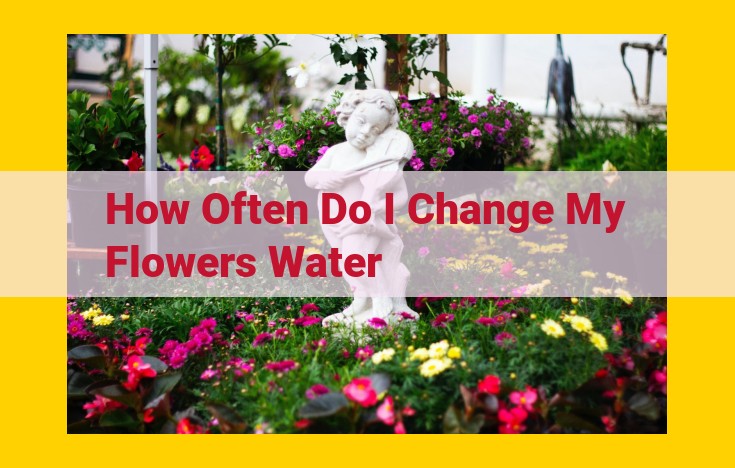For optimal flower longevity, changing water every 2-3 days is crucial. Use fresh, pH-balanced water and add flower food as directed. The amount of water depends on vase size and flower type. Regular cleaning of vases helps prevent bacteria. Additionally, maintain proper water temperature, humidity, and air flow to prolong vase life.
Understanding Flower Anatomy and Its Impact on Vase Life
When it comes to making the most of your floral arrangements, understanding the anatomy of flowers is crucial. Just like people, different flowers have unique characteristics that impact their longevity in a vase.
Flower Types and Characteristics:
Flowers come in various shapes, sizes, and structures. Petals protect the reproductive organs, while sepals form a protective layer around the flower bud before it blooms. The stem not only supports the flower but also transports water and nutrients.
Influence of Flower Size, Volume, and Stem Condition:
The size and volume of a flower directly affect its vase life. Larger flowers generally have shorter lifespans due to their higher metabolic rates, requiring more water and nutrients. Stem condition is also vital – fresh, sturdy stems can absorb water efficiently, extending vase life.
Importance of Flower Freshness:
Selecting healthy flowers is key. Fresh flowers have vibrant colors, firm petals, and a sturdy stem. Avoid flowers with signs of wilting, discoloration, or damage, as they will have a shorter vase life.
Optimizing Water Conditions for Flower Care
Every flower enthusiast knows that nurturing the beauty of blooms extends beyond the initial purchase. Proper water management is the cornerstone of long-lasting flower arrangements, and understanding these key principles will elevate your floral care to new heights.
The Ideal pH Level: Nurturing a Flower-Friendly Environment
The pH level of your flower water is crucial for optimal flower health. Most flowers prefer a slightly acidic environment, with a pH range of 5.5 to 6.5. This acidic pH helps flowers absorb water more efficiently and promotes vibrant colors. Consider using specialized pH adjusters or products like lemon juice to maintain the ideal acidity level.
Water Changes: A Refreshing Revival for Your Blooms
Regular water changes are a non-negotiable aspect of flower care. Stagnant water becomes a breeding ground for bacteria and shortens the lifespan of your flowers. Replace the water every 2-3 days, or sooner if the water becomes cloudy or discolored. Always use fresh, cold water as it contains more dissolved oxygen, essential for flower respiration.
Water Level: Finding the Perfect Balance
The amount of water in your vase should be sufficient to hydrate the flowers without drowning them. Submerge the stems about 2 inches into the water, taking into account the size and volume of the flowers. Overwatering can lead to stem rot and shorten the life of your arrangement.
Flower Food: A Nutritional Boost for Cut Blooms
Flower food contains essential nutrients that nourish flowers and prolong their bloom time. Use it according to the package directions, usually mixing a packet into a gallon of water. The nutrients in flower food promote stem hydration, enhance color, and protect against disease.
Vase Hygiene: Preventing Unwelcome Guests
Clean vases thoroughly before each use to prevent bacterial growth. Wash them with hot, soapy water, rinse them thoroughly, and allow them to air dry completely. This simple step inhibits bacteria from thriving and contaminating your flower arrangements, ensuring they remain vibrant and healthy.
Creating a Favorable Environment for Flowers
Water Temperature:
- Lukewarm water is generally ideal for flowers.
- Cold water can shock the stems and inhibit water uptake.
- Hot water can damage delicate petals and accelerate wilting.
Humidity Levels:
- Maintaining high humidity levels extends flower life.
- Place vases in moist areas like bathrooms or near humidifiers.
- Mist flowers regularly to increase humidity.
- Avoid placing vases near air vents or drafts that can dry out the flowers.
Air Flow:
- Good air circulation is crucial for preventing diseases and prolonging vase life.
- Keep vases away from closed spaces with stagnant air.
- Open a window or use a fan to create gentle air flow.
- Avoid overcrowding vases, as lack of ventilation can promote mold growth.
Preventing Diseases:
- Clean vases thoroughly with soapy water before use to prevent bacterial growth.
- Use sharp scissors or shears to trim stems cleanly, removing any damaged tissue.
- Keep flowers away from direct sunlight, as UV rays can weaken petals and attract insects.
- If flowers begin to show signs of disease, remove them promptly from the arrangement to prevent it from spreading.
By creating an optimal environment, you can help your flowers flourish and enjoy their beauty for longer. Remember to consider water temperature, humidity levels, air flow, and disease prevention for a radiant floral display.
